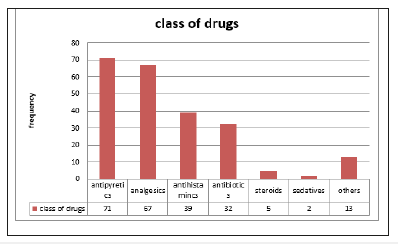- Submissions

Full Text
Developments in Clinical & Medical Pathology
Self‐Medication Patterns Among Medical Students in North India
Neelam Kotwal*, Sunil Kumar, Monika Malhotra, Imtiaz Ahmed, Bhanu Pratap and Mohammad Sarwar
1 Former Medical Officer, Jammu
2 IMO Grade 1 ESIC, Jammu
3 IMO Grade 1 ESIC, Jammu
4 IMO Grade 1 ESIC, Jammu
5 Post Graduate, Soura, India
6 Senior Resident, Soura, India
*Corresponding author: Neelam Kotwal, Former Medical Officer at Shri Mata Vaishno devi Shrine Board, Jammu
Submission: December 12, 2018;Published: April 15, 2019

ISSN:2690-9731 Volume1 Issue5
Abstract
Introduction: Self‐medication results in wastage of resources, increases resistance of pathogens and generally causes serious health hazards such as adverse drug reactions, prolonged suffering and drug dependence.
Method: A cross‐sectional descriptive study was conducted. The participants were medical students from first to final year. The data was collected using a questionnaire. The data was analyzed using SPSS version 2.0.
Result: A total of 100 students, 61 (61.00%) male and 39 (39.00%) female, were included in the study. Of the medical students surveyed, self‐medication was reported among 88%. The most common ailments for which self‐medication were used were the common cold and headache. The students consulted their textbooks and peers for the medications. Antipyretics and analgesics were the most common self‐ medicated drugs.
Conclusion: The prevalence of self‐medication among medical students is high, facilitated by the easy availability of drugs and information from textbooks or seniors. The potential problems of self‐medication should be emphasized to the students.
Keywords: Self‐medication; Medical students; Drugs
Introduction
Self‐medication can be defined as obtaining and consuming drugs without the advice of a physician for diagnosis, prescription or surveillance of treatment. [1-3] Self‐medication differs from self‐care in that it involves drugs that may do good or cause harm. [4] It has been found that inappropriate self‐medication causes wastage of resources, increases resistance of pathogens and generally causes serious health hazards such as adverse drug reactions, prolonged suffering and drug dependence [4-7].
Material and Methods
A cross‐sectional study was undertaken. The study population consisted of medical students from first to final year, within the age group of 18-25 years. The information pertaining to the pattern of self‐medication, indications for self‐medication and drugs used for self‐medication were included in the questionnaire. The data was analyzed using SPSS version 20.00.
Results
A total of 100 students participated in the study, of whom 61(61.00%) were male and 31 (39.00%) were female. A total of 88 (88.00%) participants practiced self‐medication(Figure 1-4).
Figure 1:Conditions prompting self‐ medication.

Figure 2:Class of drugs for self-medication.

Figure 3:Common sources of information for self‐ medication.

Figure 4:Sources of information.

Discussion
Self‐medication is becoming an increasingly important area within healthcare, and this study has shown that it is even more prevalent among medical students. This study has found a prevalence of self‐medication of 88 % in medical students in contrast to 59% in a non‐medical population in a previous study [2]. It is also noted that a high level of education and professional status are predictive factors for self‐medication [4]. This is like the findings in a study conducted by Erlend Hem and colleagues [6] (90%) but is higher than the findings (60%) in the study conducted by Henry James and colleagues [4].
In the study it was noticed that the classes of drugs that were commonly used were antipyretics analgesics, antihistamines and antibiotics. This is like studies done earlier [4,5]. The study has found that self‐medication is very common among medical students, facilitated by the easy availability of drugs, and information from textbooks/seniors. Since inappropriate self‐medication has the potential to cause serious harm, not only to the students themselves but also to those whom they suggest medication, potential problems of self‐ medication should be emphasized to the students to minimize this risk.
References
- Badiger S, Kundapur R, Jain A, Kumar A, Patanashetty S et al. (2012) Ullal N. Self‐ medication patterns among medical students in South India. AMJ 5(4): 217‐220.
- Shankar PR, Partha P, Shenoy N (2002) Self‐medication and non‐ doctor prescription practices in Pokhara valley, Western Nepal a questionnairebased study. BMC Fam Pract 3:17.
- Montastruc JL, Bagheri H, Geraud T, Lapeyre Mestre (1997) M. Pharmacovigilance of self‐medication. Therapie 52:105-110.
- James H, Handu SS, Khaja A, Otoom S, Sequeira RP et al. (2006) Evaluation of the knowledge, attitude and practice of self‐medication among firstyear medical students. Med Princ Pract 15: 270-275.
- Hughes CM, McElnay JC, Fleming GF Benefits and risks of self-medication. Drug Saf 24(14): 1027-1037.
- Hem E, Stokke G, Reidar Tyssen R, Grønvold NT, Vaglum P et al. (2005) Self‐prescribing among young Norwegian doctors a nine‐year follow‐up study of a nationwide sample. BMC Med 3:16.
- Kiyingi KS, Lauwo JA (1993) Drugs in home: Danger and waste. World Health Forum 14(4): 381-384.
- Sarahroodi S, Arzi A, Sawalha A.F, Ashtarinezhad A (2010) Antibiotic self‐medication among South Iranian University Students. International Journal of Pharmacology 6(1): 48‐52
© 2018 Neelam Kotwal. This is an open access article distributed under the terms of the Creative Commons Attribution License , which permits unrestricted use, distribution, and build upon your work non-commercially.
 a Creative Commons Attribution 4.0 International License. Based on a work at www.crimsonpublishers.com.
Best viewed in
a Creative Commons Attribution 4.0 International License. Based on a work at www.crimsonpublishers.com.
Best viewed in 







.jpg)






























 Editorial Board Registrations
Editorial Board Registrations Submit your Article
Submit your Article Refer a Friend
Refer a Friend Advertise With Us
Advertise With Us
.jpg)






.jpg)














.bmp)
.jpg)
.png)
.jpg)










.jpg)






.png)

.png)



.png)






